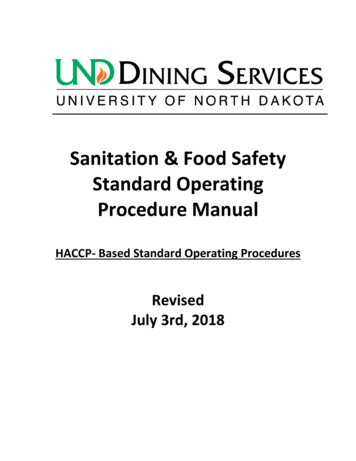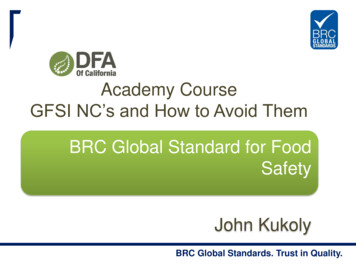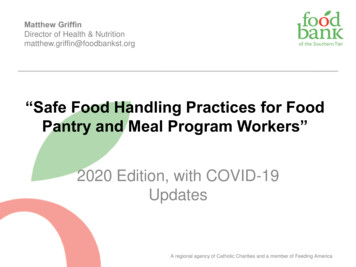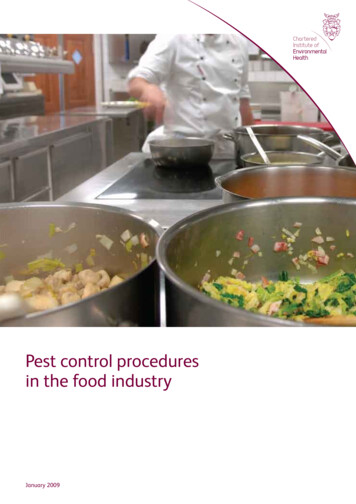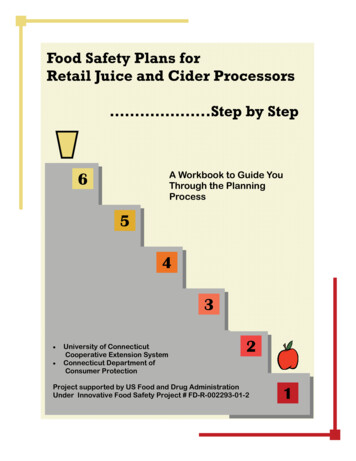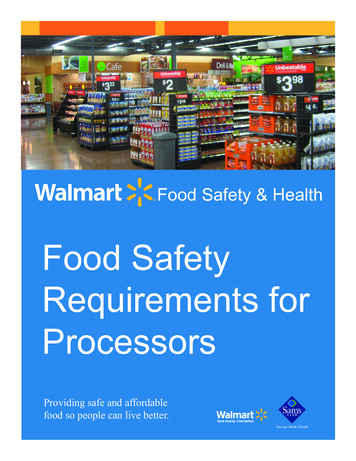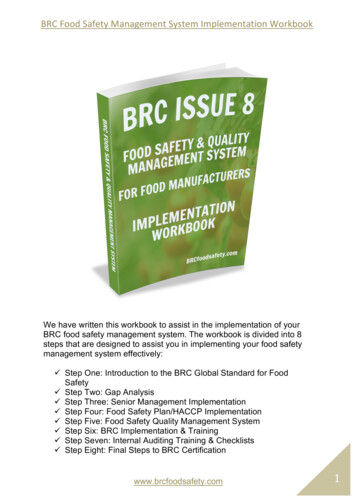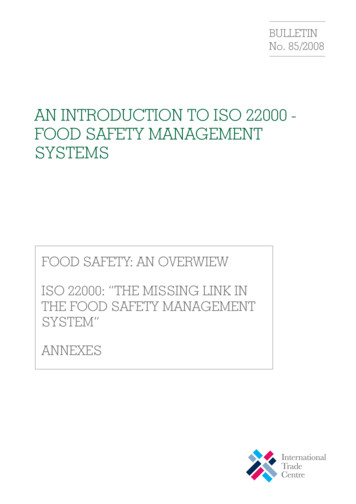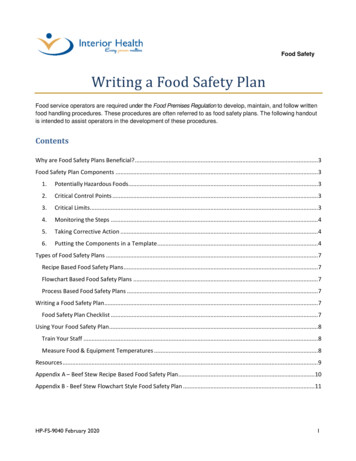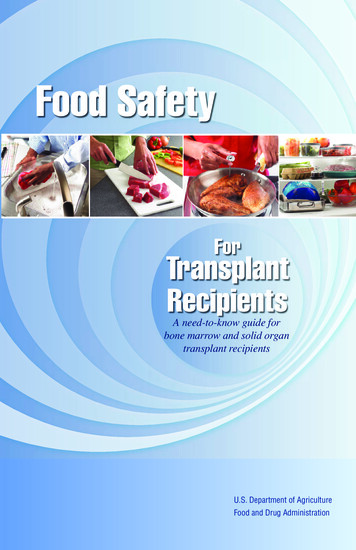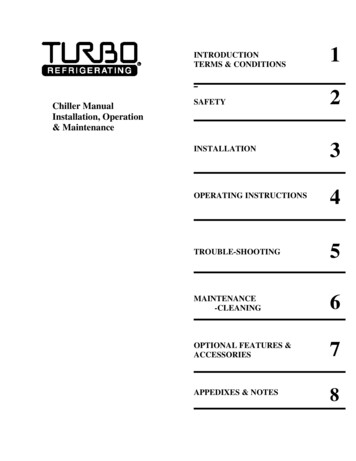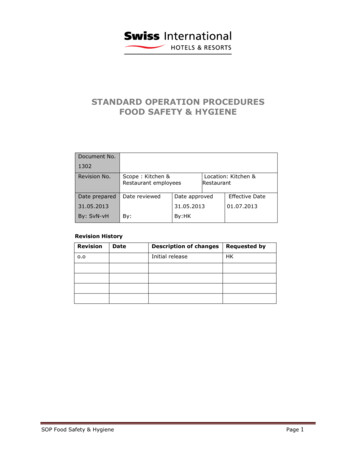
Transcription
STANDARD OPERATION PROCEDURESFOOD SAFETY & HYGIENEDocument No.1302Revision No.Scope : Kitchen &Restaurant employeesDate preparedDate reviewed31.05.2013Location: Kitchen &RestaurantDate approved31.05.2013By: SvN-vHBy:Effective Date01.07.2013By:HKRevision HistoryRevisionDateo.oSOP Food Safety & HygieneDescription of changesRequested byInitial releaseHKPage 1
SOP FOOD SAFETY & HYGIENEINTRODUCTIONSwiss International Hospitality Commons and its brands stand for International Quality –Local Affinity.At Swiss International Hotels we consistently provide our local and international guests withprofessional hospitality based on Swiss Quality and on Swiss Values.Food Safety & Hygiene is very important for the wellbeing & safety of our guests The guestwill not only experience the quality of the hotel through the comfort of his room, but alsothrough the quality of Food provided in the entire hotel. It is therefore very important thatthe concerned Kitchen employees know how to handle and process Food in a professionaland consistent manner by respecting the standards of Swiss International Hotels & Resorts.POLICYSwiss International Hospitality shall develop and maintain a clear, uniformly enforceable setof guidelines for consistent Front Office Procedures that reflects the standards of SwissInternational Hotels, based on the values of the company:SOP Food Safety & HygienePage 2
SOP FOOD SAFETY & HYGIENEAPPLYING SWISS INTERNATIONAL bilitySOP Food Safety & HygieneHOW TO WALK THE TALK Each task within the service process needs tobe completed in an economic way, withoutwasting any resources (time, effort, money,supplies etc.) whilst reaching the intendedresults (effectiveness) to ensure customersatisfaction Each task within thebe completed in awithout making anyattention to even the Thecreativity of finding new ways andmethods to complete each task and / or ofintroducing new ideas that add value andvariation to each task Being polite and showing respect & genuineconsideration and care for others is the core ofhospitality The fact of being always one step ahead ofthings that may happen and/or of requeststhat may be made by guests while completingeach task within the service process The fact of being conscience of right or wrong(moral) behaviour towards others and oneselfe.g. lying, cheating, stealing etc. Each task within the service process needs tobe completed by taking full ownership of it,which implies responsibility, and by respectingthe standards of Swiss International at anytime, which implies loyalty to the company The contribution of each and every one topreserve the natural resource of our planet iscrucial for the generations to come. In everytask to be completed one needs to consider thepossibilities to avoid pollution, waste andspillage as well as the opportunities forrecycling.service process needs toprecise and exact way,mistakes, and by payingsmallest detailsPage 3
SOP FOOD SAFETY & HYGIENEThe Standard Operation Procedures provided by Swiss International Hospitality identifythe various steps that are involved in the fulfillment of a precise task within the Foodhandling & processing, explain how to act & to proceed during each of these steps and giveexamples of how to put into action the eight Values that are defined by Swiss International.INDEX1.EMPLOYEES GUIDELINES . 61.1 EMPLOYEE PERSONAL HYGIENE . 61.2 HAND WASHING . 71.3 EATING AND DRINKING AT WORK . 71.4 GLOVE AND UTENSILS USE . 81.5 SERVICE HYGIENE STANDARDS . 81.6 LAUNDRY & LINNEN USE . 91.7 VISITORS IN THE KITCHEN . 92. ILLNESS, HAZARDS AND PEST CONTROL . 102.1 RESPONDING TO A FOOD BORNE ILLNESS COMPLAINT . 102.2 RESPONDING TO A PHYSICAL HAZARD FOUND IN FOOD . 102.3 PEST CONTROL . 113. EMERGENCIES . 123.1 CONTACT WITH BLOOD AND OTHER BODILY FLUIDS . 123.2 FOOD SAFETY IN EMERGENY SITUATIONS . 123.3 FOOD SAFETY PROGRAM VERIFICATION . 134. EQUIPMENT HANDLING . 144.1 FACILITY AND EQUIPMENT MAINTENANCE . 144.2 EQUIPMENT CLEANING AND SANITIZING . 144.3 CLEANLINESS AND SANITAZION OF THE SWISS CAFE . 154.4 MACHINE WARE WASHING – HIGH TEMPERATURE . 155.HANDLING OF FOOD PROCEDURES . 165.1 PURCHASING OF FOOD. 165.2 RECEIVING OF FOOD . 17SOP Food Safety & HygienePage 4
SOP FOOD SAFETY & HYGIENE5.3 HOLDING OF FOOD . 185.4 TASTING OF FOOD . 195.5 PREPARING OF COLD FOOD . 195.6 REHEATING FOOD . 205.7 COOKING FOOD. 205.8 COOLING FOOD . 225.9 THAWING FOOD . 235.10 SERVICE TEMPERATURES . 235.11 USE OF THERMOMETERS . 245. 12 Logbook Temperatures . 265.13 Cooling Temperature Log . 265.14 Holding Temperature Log . 275.15 Reheating Temperature Log . 285.16 Service Temperature Log . 295.17 Refrigerator and Freezer temperature Log . 305.18 Receiving Temperature Log . 316.CHECKLISTS . 326.1 CHECKLISTS AND DOCUMENTATION . 326.2 Daily Menu Production Worksheet and Temperature Log . 336.3 Dry Storage Record . 346.4 Food borne Illness Incidence Report . 356.5 Physical Hazard Incident Report . 376.6 New Restaurant Employee Orientation – Food Safety Checklist . 38SOP Food Safety & HygienePage 5
SOP FOOD SAFETY & HYGIENE1.EMPLOYEES GUIDELINES1.1 EMPLOYEE PERSONAL HYGIENEPolicy: All restaurant employees will maintain good personal hygiene practices to ensurefood safety.Procedure: All restaurant employees must: Grooming:o Arrive at work clean – clean hair, teeth brushed, and bathed with deodorantused daily.o Maintain short, clean, and polish-free fingernails. No artificial nails arepermitted in the food production area.o Wash hands (including under fingernails) and up to forearms vigorously andthoroughly with soap and warm water for a period of 20 seconds: When entering the facility before work begins. Immediately before preparing food or handling equipment. As often as necessary during food preparation when contamination occurs. In the restroom after toilet use, and when you return to your workstation. When switching between working with raw foods and working with readyto-eat or cooked foods. After touching face, nose, hair, or any other body part, and after sneezingor coughing. After cleaning tables. After cleaning duties. Between each task performed and before wearing disposable gloves. After smoking, eating, or drinking. Any other time an unsanitary task has been performed – i.e. taking outgarbage, handling cleaning chemicals, wiping tables, picking up a droppedfood item, etc.o Wash hands only in hand sinks designated for that purpose.o Dry hands with single use towels. Turn off faucets using a paper towel in orderto prevent recontamination of clean hands.o Change disposable gloves as often as hand washing is required. Wash handsbefore donning and after discarding gloves Proper Attire:o Wear appropriate clothing – clean uniform with sleeves and clean non-skid,close-toed work shoes (or leather tennis shoes) that are comfortable forstanding and working on floors that can be slippery.o Wear apron on site, as appropriate.o Do not wear apron to and from work.o Take off apron before using the restroom.o Change apron if it becomes soiled or stained.SOP Food Safety & HygienePage 6
SOP FOOD SAFETY & HYGIENE Hair Restraints and Jewelry:o Wear a hair net or cap in any food production area that completely covers allhair.o Keep beards and mustaches neat and trimmed. Beard restraints are requiredin any food production area.o Refrain from wearing jewelry in the food production area.o Only a plain wedding band is permitted.o No necklaces, bracelets, or dangling jewelry are permitted.o No earrings or piercing that can be removed are permitted.Cuts, Abrasions, and Burns:o Bandage any cut, abrasion, or burn that has broken the skin.o Cover bandages on hands with gloves and finger cots as appropriate.o Inform floor manager of all wounds.Smoking, eating, and gum chewing:o Smoke only in designated areas. No smoking or chewing tobacco shall occurinside production facilities.o Eat and drink in designated areas only. A glass of water or a closed beveragecontainer may be used in the production area, when put out of sight.o Refrain from chewing gum or eating candy during work in a food productionarea.1.2 HAND WASHINGPolicy: All food production and service personnel will follow proper hand washing practicesto ensure the safety of food served to customers.Procedure: All employees involved in handling food must wash hands using the followingsteps: Wash hands (including under the fingernails) and forearms vigorously and thoroughlywith soap and warm water (water temperature should be at least 100ºF) for a periodof 20 seconds. Wash hands using soap from a soap dispenser. Lather at least 10 seconds. Use a sanitary nail brush to remove dirt from under fingernails. Wash between fingers thoroughly. Use only hand sinks designated for that purpose. Do not wash hands in sinks in theproduction area. Dry hands with single use towels or a mechanical hot dryer. (Retractable cloth toweldispenser systems are not recommended.) Turn off faucets using a paper towel inorder to prevent recontamination of clean hands if foot pedals are not available.1.3 EATING AND DRINKING AT WORKPolicy: Restaurant employees will eat and drink in designated areas outside of the kitchen.Procedure: All restaurant employees must: Eat and drink in designated areas only, never in the work area. Eating (with theexception of cooks tasting foods to ensure quality) is NOT allowed in the productionand service areas. Drinking from a closed beverage container or glass of water ispermitted in production area, when placed out of sight.SOP Food Safety & HygienePage 7
SOP FOOD SAFETY & HYGIENE Chew gum or eat candy only in the area designated for employees to eat.1.4 GLOVE AND UTENSILS USEPolicy: Gloves or utensils will be used for handling all ready-to-eat foods and when thereare cuts, sores, burns, or lesions on the hands of food handlers.Procedure: All employees handling food or utensils must: Wash hands thoroughly prior to putting on gloves and when gloves are changed. Change gloves when:o Beginning each new task.o They become soiled or torn.o They are in continual use for four hours.o Finished handling raw meat and before handling cooked or ready-to-eat foods. Use utensils, such as deli-tissue, spatulas, or tongs, as an alternative to gloves. Cover cuts and sores on hands, including fingernails, with clean bandages. If handsare bandaged, clean gloves or finger cots (protective coverings) should be worn at alltimes to protect the bandage and to prevent it from falling into food.1.5 SERVICE HYGIENE STANDARDSPolicy: All food will be served in a manner to ensure food safety.Procedure: Employees involved in the service of food must observe the followingprocedures: Cleaning and sanitation:o Before food is placed in service area clean on around the service area, usingwarm soapy water and designated clean cloths. Thoroughly rinse afterwashing.o Sanitize on and around the service area, using an approved chemical sanitizerat proper concentration.o Wipe down area as needed throughout service with cloth stored in sanitizingsolution away from food.o
SOP FOOD SAFETY & HYGIENE SOP Food Safety & Hygiene Page 4 The Standard Operation Procedures provided by Swiss International Hospitality identify the various steps that are involved in the fulfillment of a precise task within the Food
